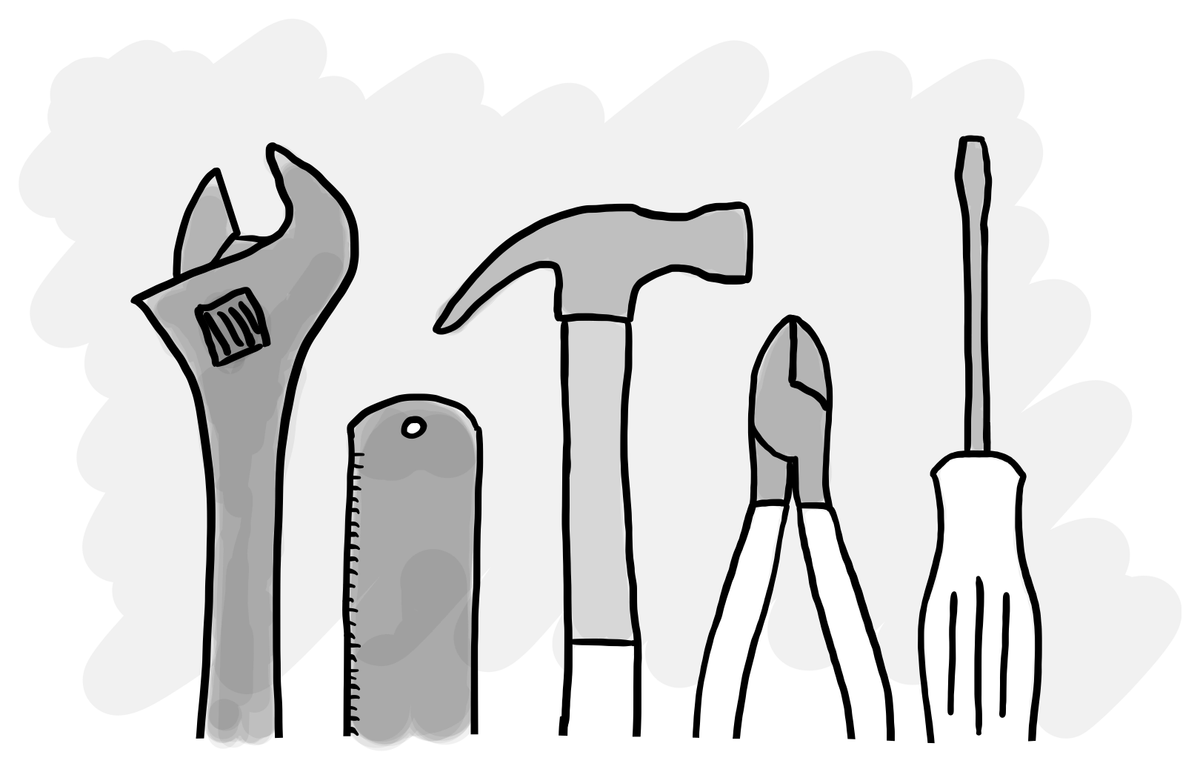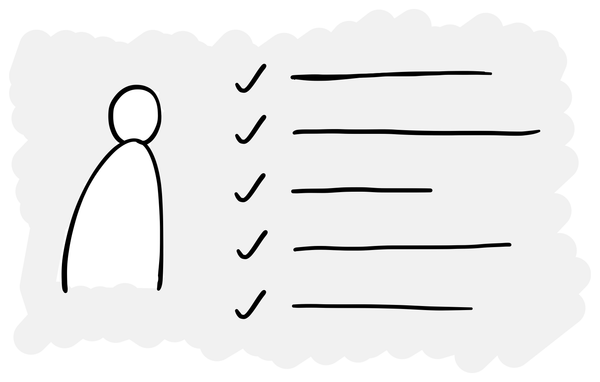A practical introduction to market research, for UX researchers
It’s time to find out what those other researchers do.

There are two trends that I’m seeing at the moment:
Trend 1: Researchers are doing more strategic research
The democratisation of UX research is changing the role of researchers in two ways:
- To help designers, product managers and others conduct their own research, they’re expected to do more coaching and governance work (e.g. creating templates).
- The research they are doing is more strategic in nature and often sits outside of product squads.
Research teams are increasingly organising themselves to reflect this. A common emerging pattern is to divide the research team in two, with some researchers focused on supporting product squads while the others work on more strategic research briefs.
Trend 2: Strategic briefs can’t be solved with UX research methods alone
I’m seeing more and more research briefs with broad objectives that can’t be solved by UX research methods alone.
These include things like:
- Market sizing
- Societal, cultural and industry trends analysis
- Social listening
UX research and market research are similar in many ways, but the two disciplines rarely intermingle. Many large companies have separate teams for UX research (reporting into the CPO/CTO) and market research (reporting into the CMO).
Previously stakeholders would send their briefs to one team or the other, but I see more and more briefs which require the skills of both.
It’s time to learn about market research
Like many people who were trained as UX researchers, I haven’t had much exposure to market research tools and techniques beyond basic desk research and quant surveys.
It was only recently when I started working with the wonderful Jane Hovey - who comes from a brand and marketing strategy background - that I started to learn all about the tools and techniques used in market and brand research.
The more I learn, the more I think it’s important for UX researchers to upskill in this area. When you can combine primary qual and quant, secondary research and data analysis, there aren’t any insights you can’t gather.
I couldn’t find anything like this out there, so I thought I’d write it for myself. I hope it’s of use to other people with a UX research background in getting to grips with the tools and techniques that you can add to your skillset.
Similar methods, but with a different purpose
There are plenty of articles about the difference between UX and market research, so I’ll keep it brief:
- Market research is focused on the market for a product or service and answers questions about things like:
- Who are our competitors and what are they doing?
- Who are our customers (or potential customers)?
- How big is the market for this product?
- What are the trends in the industry?
- How do people perceive our brand?
- UX research is focused on how people interact with a product or service and (as I’m sure you know) answers questions like:
- What needs and challenges do people have?
- How do people use this product?
- Is it meeting their needs?
There’s of course a lot of overlap - especially when it comes to research into customers’ needs, attitudes and behaviours - but fundamentally the difference is in the purpose of the research i.e. why you are doing it.
The main adjustment you have to make as a UX researcher coming to this for the first time is to zoom out and think about broader consumer attitudes and market trends.
Categories of market research
UX researchers should find these categories familiar because all market research methods ultimately boil down to either talking to people, observing people or analysing data, just like UX research.
- Primary vs secondary research: Primary research means you are collecting new data firsthand for a specific purpose (e.g. running a survey, conducting a focus group or interviewing customers directly). Secondary research (a.k.a. desk research) means you are analysing data that already exists, which could be from numerous sources - more on that later.
- Qualitative vs quantitative methods: similar to UX research, there are qual methods where we are seeking to understand the ‘why’ and go into a lot of depth with a few people, and quant methods that seek broader and more representative findings about attitudes and behaviours by speaking to many more people.
- Formative vs evaluative research: Formative is about understanding the problem space (e.g. what people’s needs are) while evaluative is about the solution space i.e. understanding if the thing we have created (e.g. a product or brand campaign) aligns with those needs.
Primary research methods
Qual
Some of these will seem familiar to UX researchers, but the main difference is the purpose these methods are used for and the skills used in them, for example projective techniques (where you try to reveal people’s unconscious thoughts on various topics).
- One-to-one interviews: often semi-structured, focusing on broader attitudes, needs, brand associations or product perceptions.
- Focus groups: used to explore group dynamics, shared attitudes and reactions to concepts. More common in market research than UX.
- Ethnographic and in-situ research: observing real-world behaviour in context.
- Shop-alongs: a subset of ethnography used to explore decision-making in retail environments.
- Customer immersion/video ethnography: often recorded sessions of people using products in their daily lives, for example the experience of unboxing a product.
- Diary studies: capturing behaviour and reflections over time, often used for longitudinal insights.
- Triads and mini focus groups: smaller group sessions (2–4 people) to balance depth and group interaction.
Quant
- Large-scale surveys: the workhorse of market research, used for concept testing, segmentation, pricing studies, etc.
- Tracking studies and longitudinal surveys: repeated measurement of the same thing over time (e.g. brand tracking, NPS tracking, campaign effectiveness).
- Methods for evaluating preferences in a more structured and rigorous way:
- MaxDiff: used to prioritise features or messages by asking respondents to select the most and least important from a set, e.g. “Here’s a list of 10 ingredients. Tell us which ones you most and least want on your sandwich.”
- Conjoint analysis: used to test how the relative value of different features by analysing choices across many different combinations, e.g. “Here are three different sandwiches, each with a different combo of bread, filling, and price. Which do you prefer?”
- Monadic and sequential monadic testing: showing participants one or more product concepts (individually or sequentially) to evaluate appeal or performance without bias, e.g. “Here’s one sandwich. Would you buy it? Now here’s a second one, same question.” Most UX researchers will be familiar with this, but you might not have heard it called this.
- A/B or multivariate testing: while often associated with product or marketing experimentation, it’s a valid primary quant method when tightly controlled (e.g. regional rollouts or split tests).
Secondary research methods
Secondary research is about finding and analysing existing information to answer your question. This is the area which I think many UX researchers will find the most value in expanding their skills and experience.
The internal sources below will be familiar, but most UX researchers aren’t super experienced with external secondary sources. After all, the focus of our job is typically to conduct primary research.
Internal sources
- Analytics and other BI data: things like product usage data, web analytics and dashboardss.
- Previous research: even if they weren’t answering your exact question, there’s often transferable insight from prior research.
- Sales and support conversations: call transcripts, CRM notes and support tickets.
- Customer feedback and NPS data: including survey responses and satisfaction data.
External sources
- Market research portals: these are useful because using existing data is quicker and cheaper than running your own primary research:
- Survey-based platforms (e.g. GWI, YouGov): these run large-scale, recurring surveys across many markets to capture consumer attitudes, behaviours, media usage and demographics.
- Industry report publishers (e.g. Mintel, Euromonitor, IBISWorld): have in-house analysts who produce detailed reports on various industries.
- Data aggregators (e.g. Statista, MarketResearch.com): collect and visualise statistics from third-party sources like governments and trade associations.
- Trends platforms: sites like TrendWatching, Exploding Topics and Think with Google analyse data from many sources (e.g. search, social, startups) to identify and categorise trends.
- Government, NGO and trade body reports: public sources like the ONS, World Bank, OECD and industry associations often have free data on things like market sizes and demographics.
- Company websites and investor materials: annual reports, investor materials and press releases are useful when you’re analysing a single business or competitor set.
- Competitor research: product reviews, pricing pages, feature comparisons, app store feedback, etc.
- Library databases and public business centres: resources like IBISWorld or Mintel are often free via local libraries (e.g. the British Library Business & IP Centre).
- Academic research and journals: sites like Google Scholar, JSTOR and Pew Research can give you societal and long-term behavioural trends.
- Press and industry coverage: news stories, trade magazines, expert interviews and conference round-ups can help you get up to speed in a new industry.
- Social listening: tracking what people say about products, brands, and needs across public conversations
- Social networks and communities (e.g. Reddit, YouTube, TikTok, Instagram, Facebook, Mumsnet, Quora): you can browse comments, posts and discussions manually or use AI to extract sentiment and themes in a semi-automated way.
- Automated tools (e.g. BrandMentions, Talkwalker, Meltwater, Google Alerts): these aggregate mentions across platforms, track sentiment and visualise trends.
- Patent and IP databases: in technical markets, platforms like Google Patents or Espacenet might be useful for certain projects.
- ChatGPT and other AI tools: good for finding sources, especially if you are using Deep Research or similar.
Types of market research briefs
Finally, let’s take a quick look at how these methods are typically used to solve business problems. Here are the main use cases:
- Sizing a market and assessing demand: “How big is the market for X? How many people might want this product, and how much would they use or pay for it?” To do this, you might start with secondary data and statistics, then do a quant survey if you didn’t have sufficient data.
- Identifying and profiling customer segments: “Who are our customers (or potential customers)? What distinct groups exist within the market?” You’d typically use a large-scale quant survey to identify and cluster segments, and follow up with qual interviews to understand the motivations and behaviours behind each group.
- Spotting trends and emerging behaviours: “What changes in technology, culture or habits might shape the market in the next 1–3 years?” This usually starts with trend reports, news coverage and social listening. You might then run expert interviews to explore what these shifts could mean for your business.
- Understanding competitors and market positioning: “What are competitors offering, and how do we stand out?” Secondary research is the main method for this. You might also run qual interviews or quant surveys to compare brand perceptions or feature preferences.
- Testing concepts: “Which of these ideas is most appealing? What needs to change before launch?” Similar to concept testing in UX research, but this might be for marketing campaigns rather than just product or service design.
- Prioritising features or benefits: “What should we focus on first? Which messages or features matter most to customers?” Methods like MaxDiff or conjoint analysis help you structure trade-offs and identify what really drives preference, especially when you’ve got too many options to build or say at once.
- Measuring brand awareness and perception: “Do people know about us? What do they think of our brand?”Run quant surveys to measure unprompted and prompted brand awareness, as well as associations or perceptions. You might also track changes over time with a brand tracker or sentiment analysis.
- Tracking satisfaction and loyalty: “Are our customers happy? Will they stay or recommend us?” Use quant surveys like CSAT or NPS to measure satisfaction over time. Supplement with qual interviews or open-text responses to understand pain points and what’s driving scores up or down.
- Understanding price sensitivity and finding the right pricing model: “What should we charge? How much are people willing to pay? Will they pay more for certain features?” Pricing research often uses structured quant methods like conjoint analysis (to test different bundles and price points) or Van Westendorp pricing (to identify acceptable price ranges).
Be curious
What I’ve learned from exploring these methods recently is that market research isn’t something that someone else does. UX researchers can do this stuff too! You might not have experience using these techniques, but they are adjacent enough that you could pick them up with a bit of guidance and coaching.
With more people working on strategic briefs, I think it’s inevitable that we’ll see more people starting to blend UX research and market research. It’s a good time to be curious and start learning what those people in the ‘other’ research team do.




